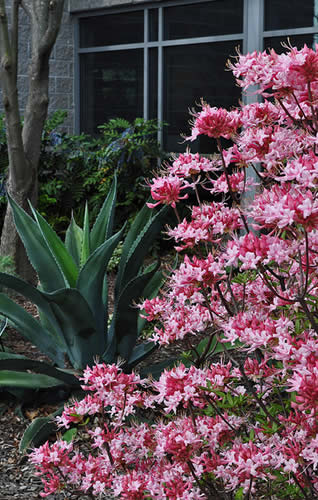Varnadoe's Phlox Pink Native Azalea - Rhododendron canescens 'Varnadoe Phlox Pink' |
|
|
Ericaceae Rhododendron Canescens Varnadoe Phlox Pink |
|
| Price |
|
| Availability and Options |
Temporarily Out Of Stock This product is temporarily out of stock. Restocks typically occur at the beginning of each week. Check back soon and sorry for the inconvenience! |
| Shipping Information | |
| Grows In | Zone 6A · -10° to -5° F through Zone 9B · 25° to 30° F |
| Sun Exposure | Full / Mostly Shade, Morning Sun / Evening Shade, Dappled Light / Filtered Sun |
| Soil Drainage | Well Drained |
| Resistent To | Drought, Heat |
| Flower Color | Pink |
| Blooms | Early Spring Blooms |
| Foliage Color | Medium Green |
| Average Height | 10' to 12' |
| Average Width | 10' to 15' |
| Attracts | Visual Attention |
| Fragrances | Aromatic, Fragrant Flowers |
 More about Varnadoe's Phlox Pink...
More about Varnadoe's Phlox Pink...Varnadoe's Phlox Pink Rhododendron is a time tested, heat and humidity tolerant native azalea perfect for southern gardens. In spring, it produces full trusses of large, bright to light pink, fragrant, honeysuckle-shaped flowers that light up and fill the shade garden with a wonderful, spicy aroma. An exceptional variety of the "Piedmont Azalea" that starts blooming at a very young age.
Varnadoe's Phlox Pink Rhododendron is very easy to grow. It prefers well-drained, moist, humus rich soil and dappled shade or morning sun with afternoon shade. Once established it is quite drought tolerant, requiring supplemental water only during prolonged periods of dry summer weather.
Varnadoe's Phlox Pink is perfect for use as a large shrub or small, understory tree in woodland borders or other areas of the landscape that provide dappled shade or morning sun with afternoon shade. Use it as a specimen or plant several in a cluster.
Native Azaleas are low maintenance shrubs that require little attention once they are established.
Soil - Native azaleas prefer an acid (4.5 to 5.5), well-drained, moist but not wet, soil rich in organic matter, such as natural leaf mold, mushroom compost, composted cowe manure, or your own homemade compost. All day dappled shade or morning sun with afternoon shade is preferable. As the plant is establishing itself during the first year after planting make sure to provide water during times of summer drought.
Fertilizer - Fertilize plants just after they've bloomed with an azalea and camellia type fertilizer or an organic plant food. Mulching with a two-inch layer of aged shredded wood mulch or fresh-pine straw will help retain moisture during the warm season and will also decompose into rich organic matter that will feed the plant.
Pruning - Native azaleas do not rquire pruning however respond well to it. If you need to shape the plant up a little trim or prune right after they are finished blooming. Native Azaleas need a moist, but not wet, soil rich in organic matter ( leaf mold, rotted sawdust, compost or peat moss are examples).A shifting sun and shade situation as under pines is ideal for their light requirements.ulch to conserve moisture with any organic material such as peanut hulls, pine bark or straw, etc.
Problems - Native Azaleas are generally free of insect and disease problems.
How To Plant a Shrub in a Container or Pot